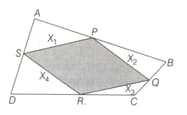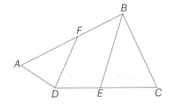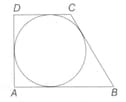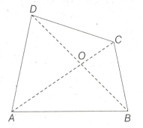A trapezium inscribes a circle that touches all its sides and the line connecting the mid-points of the non-parallel sides of the trapezium divides the trapezium in such a way that the area of one part is half the area of the other part. If the lengths of the non-parallel sides be and , find the length of the shortest side of the trapezium.

Important Questions on Geometry
(i) A kite always has two axes of symmetry
(ii) A square is both a kite and an isosceles trapezium
(iii) Every kite is an orthodiagonal
(iv) An isosceles trapezium can have a circumcircle
(v) A kite can always have an incircle
(vi) If the sum of two opposite sides is not the same as the sum of the other pair of opposite sides, it can never be a circumscribing quadrilateral.
(i) The intersections of the angle bisectors of the quadrilateral are the vertices of the cyclic quadrilateral.
(ii) If diagonals of a cyclic quadrilateral perpendicularly intersect at point P, then the line through P. perpendicular to any side bisects the opposite side.
(iii) The product of the lengths of the two diagonals of a cyclic quadrilateral is equal to the sum of the products of opposite sides.
Which of the following is correct, considering the given figure, in which and are the mid-points of and , respectively?

(i) The perimeter of the parallelogram is equal to the sum of the diagonals of the quadrilateral
(ii)
(iii)
In the following quadrilateral and are the mid-points of and , respectively. If the area of is and that of is , what is the area of quadrilateral ?

A trapezium inscribes a circle. The two sides and are parallel and the diameter of the circle is equal to the length of side If , find the perimeter of the trapezium .

In the following quadrilateral and are the diagonals intersecting at a point inside the quadrilateral. The area of is and area of is . What is the minimum possible area of the quadrilateral

